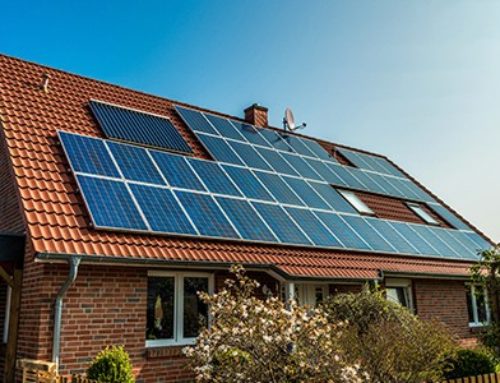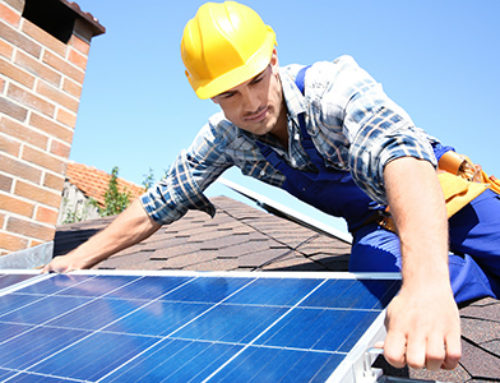Solar energy is quickly becoming the renewable energy source of choice. Because of this, technology is expanding rapidly, and consumers are spoilt for choice when it comes to solar energy solutions.
Commercial and residential solar energy systems can provide power to large properties, businesses, and homes. If, however, you are looking for a portable power solution to take with you on your next adventure, a small solar power panel that can be combined with a battery might just be what you need.
What are portable solar panels?
A portable solar panel is similar to the panels you may install on the roof of your house. Unlike traditional solar installations, small solar panels are more compact and can be moved around instead of being fixed or mounted. They are great for generating your own renewable energy but do not need to support the energy needs of an entire home.
Some small solar panels could supply power to multiple devices, while others, like a solar charger, could only generate enough electricity to charge one device at a time.
What is considered to be small solar panels?
There are two ways to define small solar panels, and there are various small solar panel options to choose from. The first refers to their physical dimensions, while the second refers to the amount of wattage (electricity or power output) that the panel can produce. A solar power panel consists of multiple solar cells that are connected to each other. These cells are responsible for the power output of the system. Typically, smaller panels have fewer cells and thus produce less wattage (or have a lower power output) than larger panels.
Solar cells are always 6.14 by 6.14 inches. Most solar power panels used for home solar panel installation have either 60 or 72 cells. These panels are usually around 65 inches long and 39 inches wide. Small, portable solar panels can range between 8 to slightly over 30 inches long and between 13 and just over 27 inches wide.
Larger solar panels, like the ones you might install on your house’s roof, can generate between 250 and 400 watts. Small panels can generate anything between 20 and 300 watts. Here is some more information on 200 watt solar panels. The wattage generating capacity usually corresponds with the size of the solar power panel. You could connect multiple small solar panels. How many solar panels you need will depend on your energy usage.
How efficient are small solar panels?
Wattage is not the only factor to consider when looking for a small solar panel. You also need to consider the panel’s efficiency. A panel’s efficiency will influence the wattage that it can produce while exposed to sunlight.
Different types of solar panels have different levels of efficiency. When it comes to solar panels, efficiency refers to the percentage of sunlight energy that it can convert into electricity. In other words, how much of the sunlight that hits the panel can be used to power appliances in your home or to charge your phone.
Most solar panels have an efficiency of between 15 and 20%. Monocrystalline solar panels made out of monocrystalline solar cells have a slightly higher efficiency (between 22 and 27%). Polycrystalline solar panels and thin-film solar panels (flexible solar panels) have an efficiency of between 15 and 22%.
You may notice that a manufacturer states that their solar cells have an efficiency of in excess of 40%. This stated efficiency usually reflects a cell’s (or panel’s) performance under perfect conditions in a laboratory. The efficiency of your small solar panel could be less than this, depending on how it is set up, its angle to the sun, and how much sunlight directly and uninterruptedly reaches the surface of the panel for a specific amount of time.
Two panels of different sizes with the same efficiency will produce different amounts of watts because one will have more individual cells that generate power. That means a smaller solar power panel with a higher efficiency could potentially generate a similar amount of power as a larger solar panel with a lower efficiency.
Read more about the best portable panels.
How do small solar panels work?
Small solar panels work the same as larger solar panels, only on a much smaller scale. The photovoltaic cells are placed in the sunlight. They then absorb the sunlight energy and convert it into electrical energy. The power produced by your solar panel system is measured in watts (W).
Solar cells are made out of a semiconductive material like silicon. This material reacts when it gets into contact with sunlight to produce electricity. This reaction continues as long as the cells are exposed to sunlight.
The electricity produced is in the form of a DC current. It then needs to move through a solar inverter to change it to AC current. Most appliances use AC electricity, so this step is vital.
Follow this link if you are still wondering: “How does solar work?”
Pros and cons of small solar panels.
Portable solar panels are more compact and lightweight than regular solar panels. That makes them great for any activity where you may need to move them around, like boating, backpacking, camping, and hiking. Because they are light, they are relatively easy to carry and won’t place strain on the roof of your RV.
One of the drawbacks of mini solar panels is that they tend to generate less power than larger panels. A very small solar panel may be convenient and easy to pack but might not generate enough electricity for your needs. Large RVs that use plenty of appliances will require larger panels (or multiple smaller ones).
However, small solar panels can power numerous devices that do not require a lot of electricity. This includes watches, flashlights, mobile phones, radios or speakers, cameras, and even laptops.
Small solar panels will only be able to provide you with electricity as long as the sun shines. To use electricity from your small solar panel during the night or on cloudy and rainy days, you will need to store electricity that is generated while the sun does shine. You can do this by using a solar battery. The battery connects to your portable solar power system. Some of the electricity that is generated by the solar system gets stored in the battery pack for later use. If you do add a battery bank to your small solar system, you will also need to include a charge controller. A charge controller ensures that the battery does not get overcharged.
Portable solar panels are more versatile than larger, mounted solar panel systems. They can be placed or mounted just about anywhere. What is more, you could use a small solar panel to supplement grid energy use in your home. These plug-in solar devices can generate up to around 600 watts per solar module. They can be plugged into a wall outlet to feed the electricity they generate into the grid. You can then use this electricity in your home.
Wondering whether the solar panel cost is worth it, take a look at this article.
How to clean your small solar panel.
Regardless of their size, solar panels do not require a lot of maintenance. Usually, all you need to do is make sure the panel stays clean, and no dirt or debris covers the surface (which will affect its efficiency). Fixed panels should be cleaned between two and four times a year. It is good practice to clean your portable solar panel after each use – usually, a quick wipe-down will do.
The best time to clean your small solar panel is either when you are packing it away or in the morning or evening when it is not exposed to direct sunlight. You could, therefore, also clean it on an overcast day. Solar panels that are exposed to the sun could get hot, and any water that you use to clean the panel will evaporate quickly – leaving you with a streaky mess.
Avoid using anything that can scratch your solar panel. This includes abrasive powders, metal objects, or hard-bristled brushes. A scratch on your small solar panel could cause shadows and thus affect its efficiency in generating electricity. The same goes for detergents that can leave streaks.
For the best results, use clean water along with a sponge covered with a rough cloth. You can remove stubborn grime with a soft brush or plastic scourer. It is best to use water that does not contain a lot of minerals to avoid any minerals being left on the surface of the solar panel. Rainwater or soft water (water without calcium and magnesium) is best. Use a squeegee to dry your solar panel after it’s been cleaned.
If you need to clean snow off of your small solar panel, use lukewarm water if you have to. Using hot water could cause the tempered glass component of your solar panel to crack.
The size of the solar generator that you need will depend on your energy usage. Having a small power station can help you stay connected and keep your devices and camping equipment charged while enjoying time away from home. It could also supplement your fixed solar installation or grid power if you use a plug-in model.
Find more helpful Going Solar resources here.


